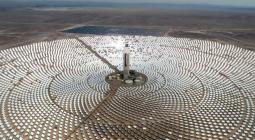Putin's war, Biden's green law, China's surge | Seven reasons for energy transition fear and cheer

AGENDA SPECIAL | The final Agenda of this year brings you Recharge’s seven reasons for energy transition cheer and fear from 2022 – and our best wishes for a happy and peaceful holiday season.
1. War in Ukraine
Vladimir Putin's brutal invasion cast a long funereal shadow over 2022, sparking a global energy crisis and an exodus of green power players from the Russian economy. While it’s hard to find positives in such a grim scenario, the dash from Moscow-controlled gas has at least put major impetus behind efforts to build independent renewables-led energy systems.
2. COP27
Like every UN climate summit of recent years COP27 opened its doors in Egypt amid doomsday warnings of the ticking clock of catastrophe if world leaders fail to move the dial on action to phase out fossil fuels and boost renewables. While there were major announcements on new projects – not least in the host country itself – and important commitments on offshore wind, the sense of disappointment at the end of COP27 was palpable, with angry accusations that oil-rich nations had stonewalled progress.
3. The IRA
This summer’s passage of the US Biden administration's Inflation Reduction Act unleashed what many hailed as the most important piece of green legislation the world has ever seen, baking-in renewables, hydrogen and other key energy transition technologies to the growth of the planet’s largest economy. The level of visibility and support offered by Washington in areas such as tax incentives has attracted envious eyes from across the Atlantic, and even sparked a full-scale trade row between America and the EU.
4. Green Hydrogen
If any doubts remained that green H2 was on the cusp of a pivotal role in the energy transition, 2022 laid them to rest. Mega projects continued to emerge around the world, with new contenders such as Djibouti joining existing big-hitters such as Australia in the race to link the most renewable power to the biggest electrolyser. Crucially, however, companies are now starting to put their money where their mouths are in the form of final investment decisions, most recently when Orsted pressed the go button on a huge e-methanol project.
5. Floating wind power
California’s milestone December auction for deepwater seabed leases was just the latest in a string of milestones for floating wind in 2022. Scotland's epic ScotWind round early in the year had already widely been hailed as the moment floating came of age in global renewables, and there was more cause for celebration when the world’s largest project so far, Hywind Tampen, began pumping power off Norway. Recharge Editor-in-Chief Darius Snieckus explains here why the only way is up for floating.
6. Chinese offshore wind
China is now applying the same awe-inspiring ambition to offshore wind as it has for more than a decade of spectacular wind and solar growth on land. The results have seen the Asian superpower blast past the UK as world’s biggest offshore wind market, while Chinese turbine manufacturers have started their own race to develop and install ever larger machines that are now leaving those from western rivals trailing in their wake, in terms of nameplate capacity at least.
7. Turbine makers in the red
Talking of western wind turbine makers, they comprise one group that will definitely be hoping for a better 2023 than ’22. With almost every major player in the red thanks to a toxic combination of stalled projects, Covid hangovers and – in some cases – operational own-goals, this year’s huge WindEnergy Hamburg industry event saw many openly voicing fears that there will be few European players left to equip the continent’s coming wind power boom.






